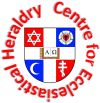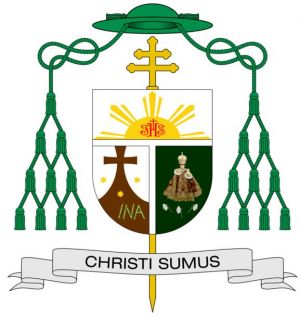Rolando Octavus Joven Tria Tirona: Difference between revisions
Knorrepoes (talk | contribs) No edit summary |
Knorrepoes (talk | contribs) |
||
| Line 16: | Line 16: | ||
===Origin/meaning=== | ===Origin/meaning=== | ||
The upper | The upper half of these 'arms' is the rising sun against a white background. The sun represents Jesus, the Sun of justice, who dispels the darkness of sin and bondage by His Resurrection. The sun's yellow color, together with its rays, symbolizes the vigor and enthusiasm with which a servant-leader is called to serve his flock. Taken together, the white and yellow colors represent the Papal flag which suggests the bishop's sharing in the office of the Apostles as well as the universal scope to which he gives himself without reserve. | ||
The lower left half bears three cotton flowers, "Bulak" in Filipino, which stand for the province of Bulacan where the Archbishop has served as the third residential Bishop of the Diocese of Malolos, and the image of the Infant Jesus of Prague, a devotion spread by the Carmelites and to which the Archbishop has a special devotion, and representing the Prelature of Infanta where the Archbishop served as the third residential Bishop as well. | The lower left half bears three cotton flowers, "Bulak" in Filipino, which stand for the province of Bulacan where the Archbishop has served as the third residential Bishop of the Diocese of Malolos, and the image of the Infant Jesus of Prague, a devotion spread by the Carmelites and to which the Archbishop has a special devotion, and representing the Prelature of Infanta where the Archbishop served as the third residential Bishop as well. | ||
Revision as of 13:26, 13 March 2020
Religious or Ecclesiastical heraldry portal
This page is part of the Ecclesiastical heraldry portal |
Heraldry of the World |
|
Catholic heraldry
|
Other Christian churches Other religions
|
ROLANDO OCTAVUS JOVEN TRIA TIRONA
Born : JUly 22, 1946
Deceased :
Auxiliary bishop of Manila, 1994-1996; Titular Bishop of Vulturaria
Bishop of Malolos, 1996-2003
Prelate of Infanta, 2003-2012
Archbishop of Cáceres, 2012-present
Official blazon
Origin/meaning
The upper half of these 'arms' is the rising sun against a white background. The sun represents Jesus, the Sun of justice, who dispels the darkness of sin and bondage by His Resurrection. The sun's yellow color, together with its rays, symbolizes the vigor and enthusiasm with which a servant-leader is called to serve his flock. Taken together, the white and yellow colors represent the Papal flag which suggests the bishop's sharing in the office of the Apostles as well as the universal scope to which he gives himself without reserve.
The lower left half bears three cotton flowers, "Bulak" in Filipino, which stand for the province of Bulacan where the Archbishop has served as the third residential Bishop of the Diocese of Malolos, and the image of the Infant Jesus of Prague, a devotion spread by the Carmelites and to which the Archbishop has a special devotion, and representing the Prelature of Infanta where the Archbishop served as the third residential Bishop as well.
The lower right half bears the shield of the Order of the Discalced Carmelites, of which the new Archbishop is a member. It features a mountain crowned with the Cross and flanked with three stars of David. The mountain represents the privileged place of encounter between God and His people. The mountain is Carmel home to the prophets and mystics and all who strive the interior life. Mary stands out as Queen and Beauty of this mystical mountain. The Cross symbolizes the centrality of jesus for Carmel and for the new Archbishop's ministry. The three stars symbolize the priorities the Archbishop has outlined: the star at the base represents intimacy and union with God; the star on the left represents collaborative ministry for the Church of the Poor; and finally for the right represents concern for the gift of creation. The mountain is colored brown, symbolizing deep solidarity for all that is human. The stars are colored gold indicting the nobility and dignity of Christian vocation. All these are sent against cream background to symbolize simplicity and single-heartedness.
At the base of the mountain is the word "INA (Mother) the endearing term used to express singular devotion and love for Our Lady of Penafrancia, the Patroness and Mother of the Archdiocese of Caceres. The word "INA" recalls to mind the Carmelite Doctor of the Church, St. Therese of the Child Jesus who exclaimed: "For me Mary is more Mother than Queen!" The letters that make up the word "INA" are Pili nuts typical and well known in the Bicol Region.
Contact and Support
Partners:
Your logo here ?
Contact us
© since 1995, Heraldry of the World, Ralf Hartemink 
Index of the site
Literature : Information from the diocese












